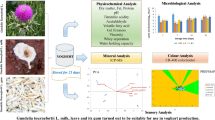Abstract
Pasta was prepared from brown rice (var. PR 118) flour incorporated with sodium alginate (0.5–2.5%), xanthan gum (0.5–2.5%), vital gluten (2–10%) and pre-gelatinized flour (10–50%) as binders. Effect of these binders on the quality characteristics of brown rice pasta was evaluated. Incorporation of xanthan gum (1.5%), vital gluten (8%), pre-gelatinized flour (40%) individually and their combination as xanthan gum (1.5%) + vital gluten (4%) + pre-gelatinized flour (20%) were found optimum to improve the cooking quality and overall acceptability of brown rice pasta. Xanthan gum (1.5%) + pre-gelatinized flour (20%) in combination can also be incorporated into brown rice in order to prepare gluten-free pasta. In addition to being a diversified convenience food, non-wheat pasta would be suitable for people suffering from wheat intolerance. Shelf life of selected pasta samples was evaluated during storage at ambient conditions for 3 months. Type of binder and storage period did not influence the cooking quality and sensory attributes of pasta significantly (p ≤ 0.05). Least significant variation was found in moisture, water activity and free fatty acid content of pasta over 3 months of storage period.


Similar content being viewed by others
References
AACC (2000) Approved Methods of American Association of Cereal Chemists, 10th edn. American Association Cereal Chemists Inc, St. Paul
Cai W, Diosady LL (1993) Model for gelatinization of wheat starch in a twin-screw extruder. J Food Sci 58:872–875
Fernandes MDS, Shen GAR, Leoro MGV, Chang YK, Steel CJ (2013) Effect of adding unconventional raw material on the technological properties of rice fresh pasta. J Food Sci Technol 33:257–264
Gallagher E, Gormley TR, Arendt EK (2004) Recent advances in the formulation of gluten-free cereal-based products. Trends Food Sci Technol 15:143–152
Gomez AK, Gomez AA (2010) Statistical procedures for agricultural research, 2nd edn. Wiley, New York
Hagenimana A, Ding X, Fang T (2006) Evaluation of rice flour modified by extrusion cooking. J Cereal Sci 43:38–46
Hager AS, Zannini E, Arendt EK (2012) Gluten free pasta—advances in research and commercialization. Cereal Food World 57:225–229
Kaur G, Sharma S, Nagi HPS, Dar BN (2012) Functional properties of pasta enriched with variable cereal brans. J Food Sci Technol 49:467–474
Kaur G, Sharma S, Nagi HPS, Ranote PS (2013) Enrichment of pasta with different plant proteins. J Food Sci Technol 50:1000–1005
Lai HM (2012) Effect of rice properties and emulsifiers on the quality of rice pasta. J Sci Food Agric 82:203–216
Larmond E (1970) Methods for sensory evaluation of food. Canada Department of Agric Publications, Ottawa
Larrosa V, Lorenzo G, Zaritzky N, Califano A (2013) Optimization of rheological properties of gluten-free pasta dough using mixture design. J Cereal Sci 57:520–526
Lazaridou A, Duta D, Papageorgiou M, Belc N, Billiaderis CG (2007) Effects of hydrocolloids on dough rheology and bread quality parameters in gluten-free formulations. J Food Eng 79:1033–1047
Lee S, Bae IY, Jung JH, Jang KI, Kin YW, Lee HG (2008) Physiochemical, textural and noodle-making properties of wheat dough containing alginate. J Texture Stud 39:393–404
Majzoobi M, Ostovan R, Farahnaky A (2011) Effects of gluten powder on the quality of wheat flour spaghetti cooked in distilled or salted water. J Texture Stud 42:468–477
Marti A, Caramanico R, Bottega G, Pagani MA (2013) Cooking behaviour of rice pasta: effect of thermal treatments and extrusion conditions. J Food Sci Technol 54:229–233
Marti A, Pagani MA (2013) What can play role of gluten in gluten free pasta? Trends Food Sci Technol 31:63–71
Marti A, Seetharaman K, Pagani MA (2010) Rice based pasta: a comparison between conventional pasta making and extrusion cooking. J Cereal Sci 52:404–409
Masur SB, Taracchand KC, Kulkarni UN (2010) Effect of incorporation of gluten and wheat bran on quality characteristics of bread flour. Karnataka J Agric Sci 23:473–475
Purnima C, Ramasarma PR, Prabhasankar P (2012) Studies on effect of additives on protein profile, microstructure and quality characteristics of pasta. J Food Sci Technol 49:50–57
Raina CS, Singh S, Bawa AS, Saxena DC (2005) Textural characteristics of pasta made from rice flour supplemented with proteins and hydrocolloids. J Texture Stud 36:402–420
Sharma S, Kaur A, Kaur G, Nanda V (2013) Influence of different protein sources on cooking and sensory quality of pasta. Int J Eng Res Appl 3:1757–1763
Sharma S, Kaur S, Dar BN, Singh B (2014) Storage stability and quality assessment of processed cereal brans. J Food Sci Technol 51:583–588
Sivaramakrishnan HP, Senge B, Chattopadhyay PK (2004) Rheological properties of rice dough for making rice bread. J Food Eng 62:37–45
Sozer N (2009) Rheological properties of rice pasta dough supplemented with protein and gums. Food Hydrocoll 23:849–855
Velioglu YS, Mazza G, Gho L, Onmah BD (1998) Antioxidant activity and total phenolics in selected fruits and vegetables and grain products. J Agric Food Chem 46:4113–4117
Vetha-Varshini PA, Azhagusundaram K (2010) Brown rice—hidden nutrients. Process Food Ind 5:27–32
Vetha-Varshini PA, Azhagusundaram K, Vijay Parveen P (2013) Brown rice—hidden nutrients. J Biosci Technol 4:503–507
Yadav DN, Balasubramanian S, Kaur J, Anand T, Singh AK (2012) Non-wheat pasta based on pearl millet flour containing barley and whey protein concentrate. J Food Sci Technol. doi:10.1007/s13197-012-0772-2
Yalcin S, Basman A (2008) Effect of gelatinization level, gum and transglutaminase on the quality characteristics of rice noodles. Int J Food Sci Technol 43:1637–1644
Yamaguchi T, Takamura H, Matoba T, Terao J (1998) HPLC method for evaluation of the free radical scavenging activity of foods by using 1,1-diphenyl-picrylhydrazyl. Biosci Biotechnol Biochem 62:1201–1220
Author information
Authors and Affiliations
Corresponding author
Rights and permissions
About this article
Cite this article
Kaur, N., Sharma, S., Yadav, D.N. et al. Quality Characterization of Brown Rice Pasta Supplemented with Vital Gluten and Hydrocolloides. Agric Res 6, 185–194 (2017). https://doi.org/10.1007/s40003-017-0250-1
Received:
Accepted:
Published:
Issue Date:
DOI: https://doi.org/10.1007/s40003-017-0250-1




